Content
- Local SEO Essentials
- How to Do Local SEO
- Google Business Profile
- Reviews & Reputation
- NAP & Citations
- Local Keyword Research & Mapping
- How To Optimize On-Page & Local Content
- Mobile Optimization for Local SEO
- Service-Area Business (SAB) Strategy
- How Do You Scale Local SEO for Multi-Location Enterprises?
- How Do You Build Off-Page Authority That Moves the Local Needle?
- How Do You Earn Visibility in Google’s AI-Powered Search (SGE)?
- How Do You Measure Local SEO Success?
- Where Should You Start with Local SEO?

Vlad Yudkin
6 August, 2025
Local SEO Guide 2025: Turn Local Searches Into Real-World Sales
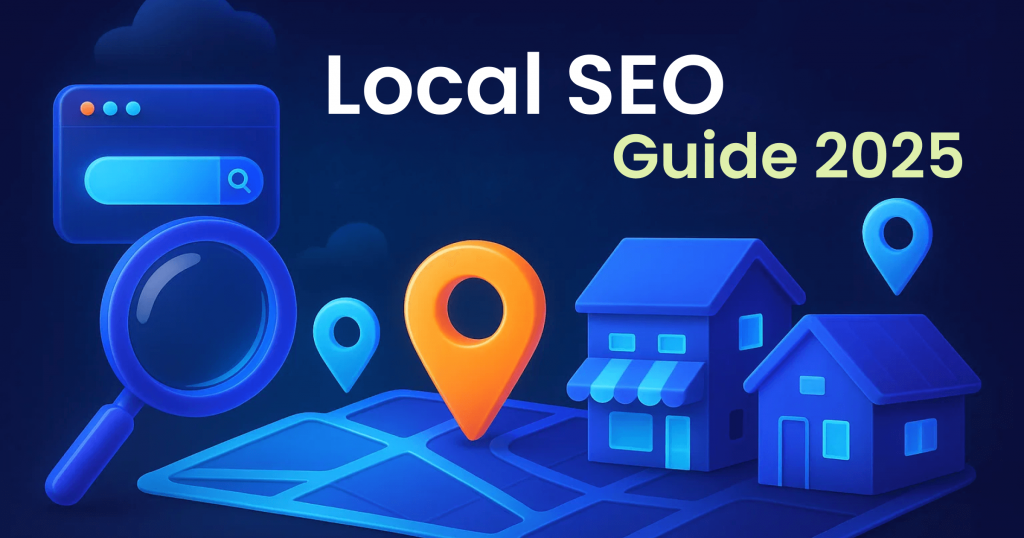
Local businesses live or die on local searches—yet many still sit buried below bigger brands and paid ads. If your Google Business Profile doesn’t reach the Map Pack, you lose walk-in customers, phone calls, and trust to competitors a block away.
That’s why local SEO is so important. This guide shows how to rank for local queries, tidy your NAP citations, collect reviews that boost clicks, and future-proof visibility for AI-driven results.
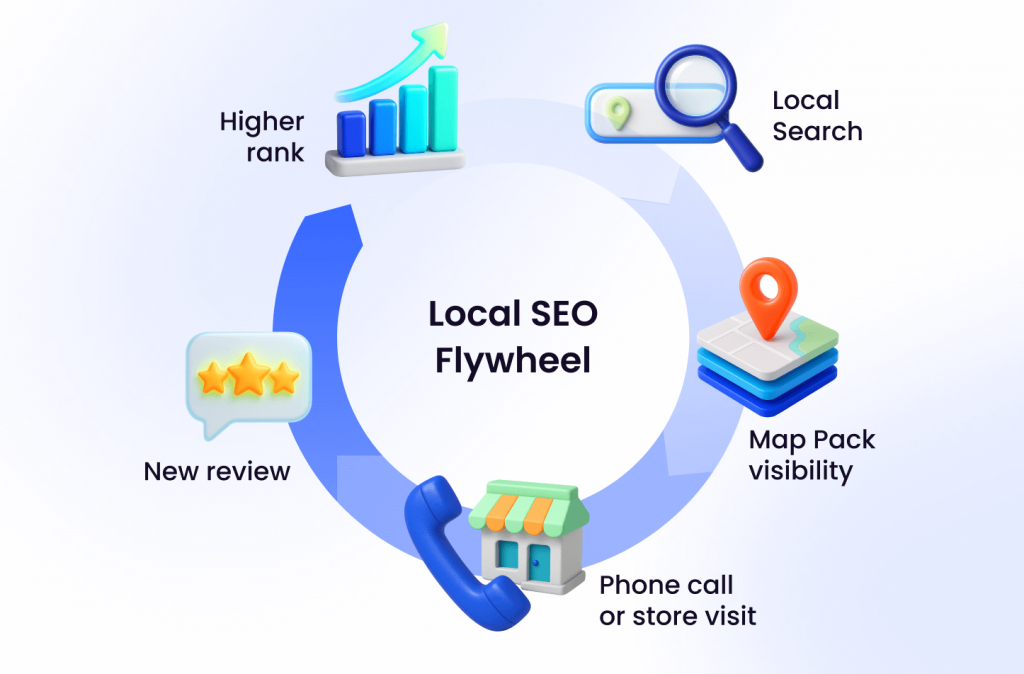
Local SEO Essentials
Local SEO isn’t plug-and-play. Before diving in, make sure you understand the essentials.
What is Local SEO and Who Needs It in 2025?
Local SEO helps Google show your business to nearby searchers right when they’re ready to buy. Any company that serves customers in a fixed area—coffee shops, HVAC firms, multi-clinic practices—needs it to own the local market.
Local SEO vs. Traditional SEO, PPC, and LSA—When Each Wins
Choosing the right customer-acquisition mix often feels like spinning plates. Traditional or national search engine optimization campaigns build a broad reach, but generic search terms rarely convert when local searchers need help two streets away.
PPC can put you on page one of the search results tonight—yet every click costs, and the meter never stops. Local Services Ads (LSA) work well for licensed trades, because Google pre-screens you and charges only per verified lead, but LSA coverage is narrow, and auction prices keep climbing.
A well-planned local SEO strategy sits in the middle. You make a one-time investment to polish your Google Business Profile—complete business details, accurate business hours, and compelling photos—align your site with service-plus-city keywords and earn reviews that signal trust.
The payoff is steady visibility in the local pack and top local results on Google Maps, giving local business owners a revenue channel that keeps working long after the ads pause. For many local businesses, PPC or LSA acts as a short-term bridge; they throttle back spend once organic local rankings and Map-Pack calls overtake paid leads.
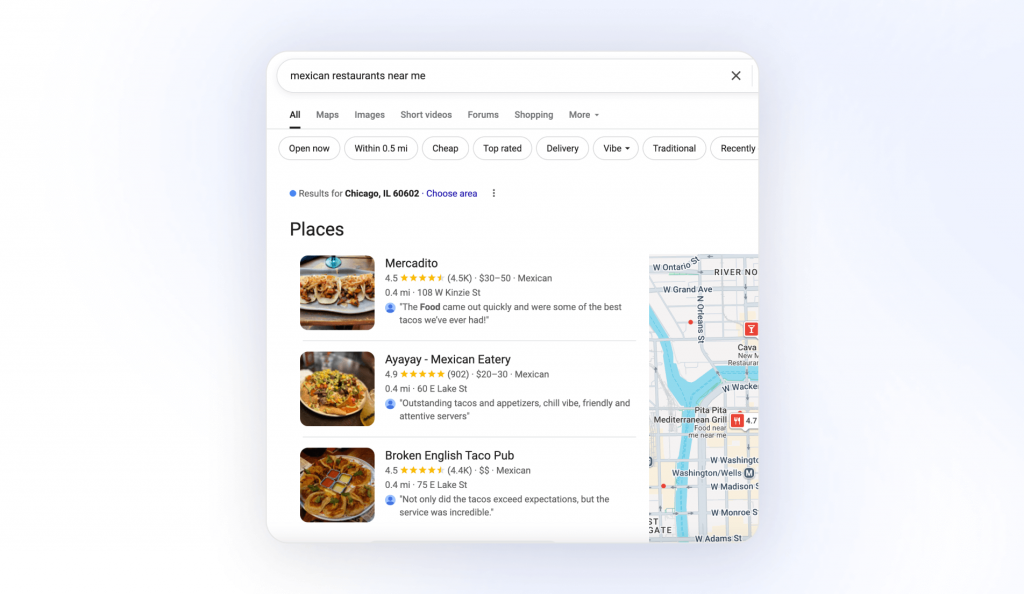
Google’s Three Ranking Pillars in Local SEO: Proximity, Relevance, Prominence
Google has published the playbook in plain sight, yet many local businesses still optimize at random.
- Proximity is the distance between the searcher and your verified address (or service-area centroid)—essentially your physical location. You cannot move your shop closer, but you can expand service areas wisely to reach nearby customers and avoid virtual office pitfalls.
- Relevance measures how clearly your Google Business Profile categories, website copy, and structured data match the search queries. When a user types “emergency vet open now”, a profile with the exact service listed and accurate business hours leaps to the front of the local results.
- Prominence reflects your offline and online reputation. Consistent NAP citations, steady five-star reviews, and mentions from local news sites tell search engines—and humans—that you are the trusted choice, which in turn improves your local rankings on Google Maps.
Where Will You Appear? Map Pack, Local Finder, or Organic
Many assume ranking “somewhere on page one” of the Google Search results is enough. In reality, clicks cluster at the top of the visual map box:
- Map Pack (the top 3 pins, also called the local pack) captures ~42% of clicks done here.
- Local Finder lists the rest of map results once users expand the map.
- Organic search results sit below; strong on-page search engine optimization pushes you here.
Winning both map and organic spots doubles your screen real estate. That’s why it’s not that easy.
Why is Local SEO Important?
If budgets are tight, you need proof that Local SEO pays. The benefits below speak to that concern:
- More calls and foot traffic – 76 % of local searchers visit within a day.
- Lower cost per lead – no ongoing ad spends once positions stabilize.
- Stronger trust – fresh reviews and first-page presence build credibility fast.
- Competitive moat – accurate citations and entity signals make it tough for copy-cats to outrank you.
How to Do Local SEO
Before we dive into the “how-to,” here’s the step-by-step path every successful local campaign follows. Think of it as your high-level checklist—each stage builds on the previous one.
- Claim and perfect your Google Business Profile
- Generate and manage customer reviews
- Fix NAP data and build core citations
- Optimize on-site pages and local schema
- Apply service area tactics for address-free coverage
- Scale strategy for multi-location brands
- Track Map-Pack keywords, calls, and other KPIs
- Earn local backlinks and authority mentions
- Prepare your entity for AI and SGE visibility
- Complete essential online listings beyond Google
In the sections below, we’ll break down what happens at each stage — a framework that works as a local SEO strategy for small businesses and for multi-location companies alike. Let’s move on!
Google Business Profile: The Asset That Puts You in the Map Pack
A fully verified, accurately categorized, and regularly updated Google Business Profile (GBP) is the single strongest lever for entering—and staying in—the Map Pack of the local results and the broader search engine results. For any local business owner, missing one critical field (address and phone number at the least) can cause search engines to bury or even suspend your local listings.
How Do You Claim and Verify a GBP in 2025?
The fastest route to ownership is still Google’s in-dashboard flow: add or locate your business → enter NAP (name address and phone) → choose verification method.
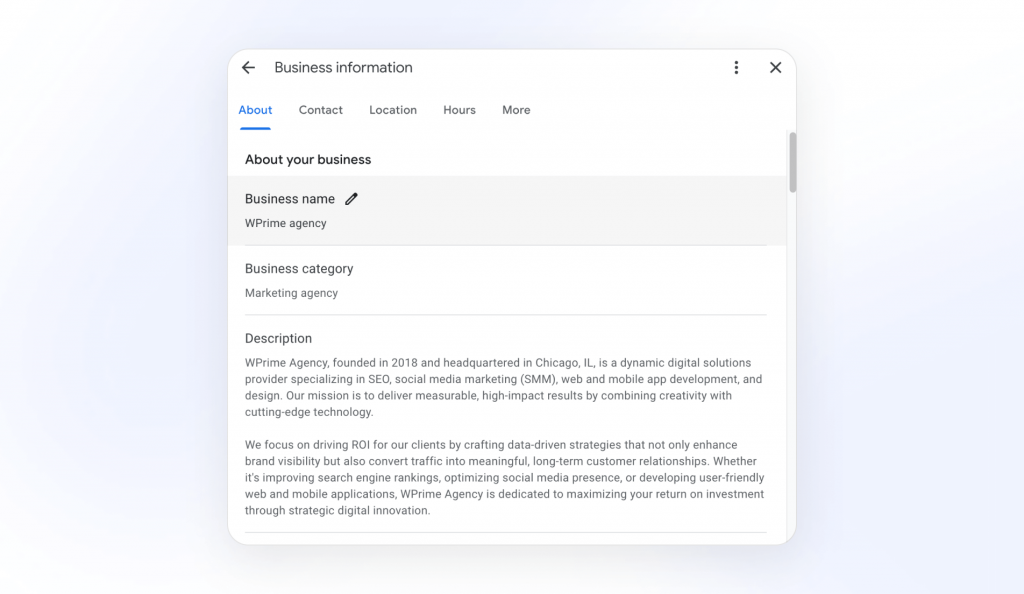
Google often pulls these into bold “Justifications” in the Map Pack and in the local organic results, nudging clicks your way.
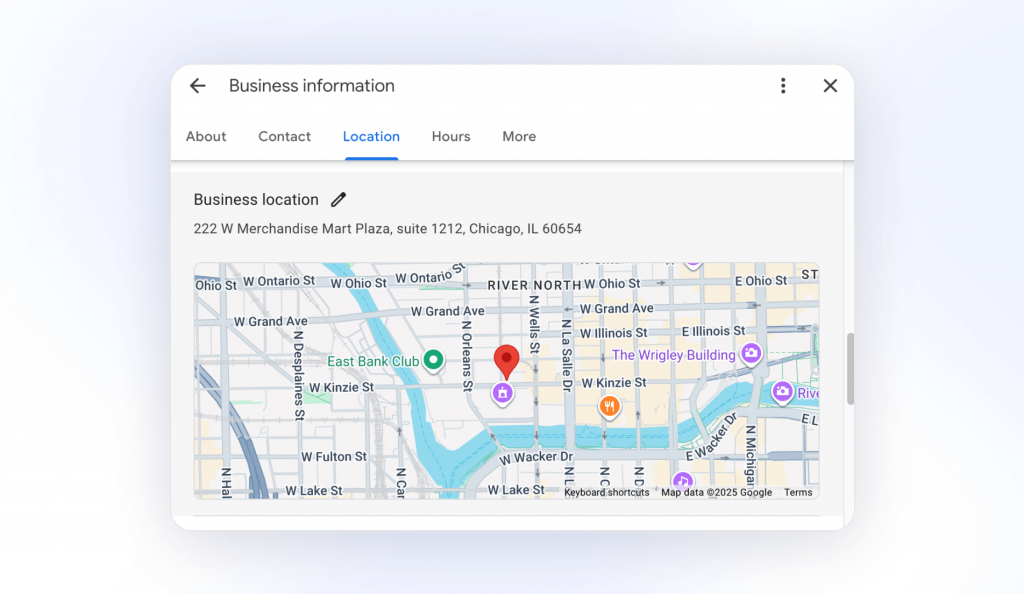
Postcard remains default, but Google now offers instant video verification for many verticals—often completed in under five minutes. Finish verification before editing other fields; incomplete changes can flag your profile for manual review and stall your local SEO optimization.
How Do You Pick the Right Categories?
Searchers (and Google) judge relevance by your primary category, so make it surgical: “Emergency Plumber” outranks the generic “Plumber” on after-hours queries. Add secondary categories only when they unlock a distinct service (e.g., “Drainage Service”). More categories ≠ more reach if they dilute topical focus and fail to improve local rankings in your local area.
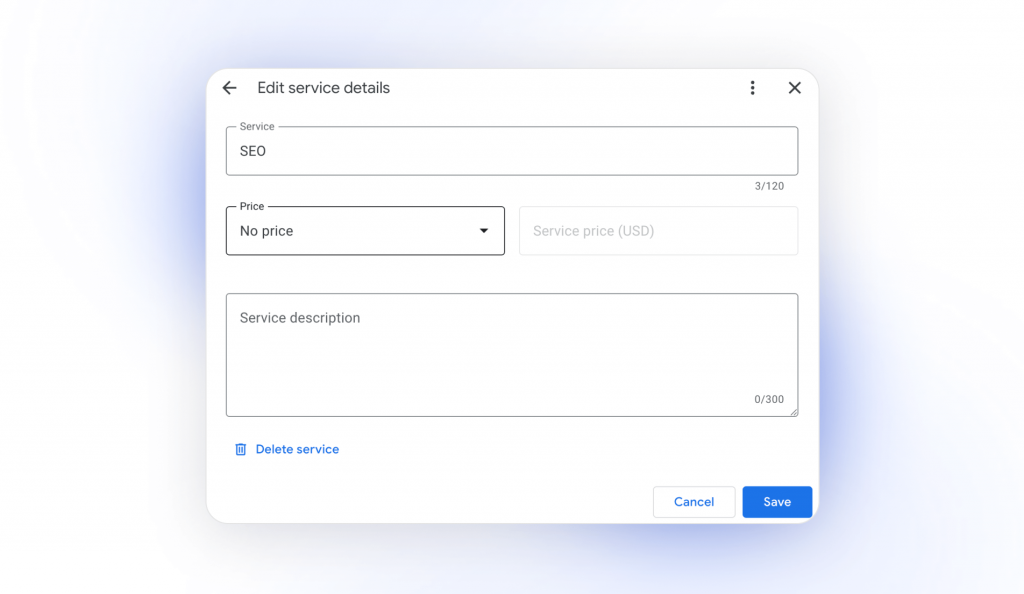
Can You Safely Add Keywords to Your Business Name to Strengthen Local SEO?
Resist the urge. Google’s 2025 guidelines stay strict: legal name only. Stuffing “Joe’s Plumbing – Best 24/7 Plumber New York” can trigger an automated soft suspension. If you’re already stuffed, edit proactively before the algorithm does it for you, and consult local SEO tools to monitor recovery.
Which Attributes Quietly Improve Click-Through Rate?
After category, attributes tell users what to expect—think “Wheelchair-Accessible Entrance,” “LGBTQ+ Friendly,” or “24/7 Emergency Service.” These now surface as mobile filter chips; leave one unchecked and you may vanish from filtered views entirely—especially when search queries carry strong local intent.
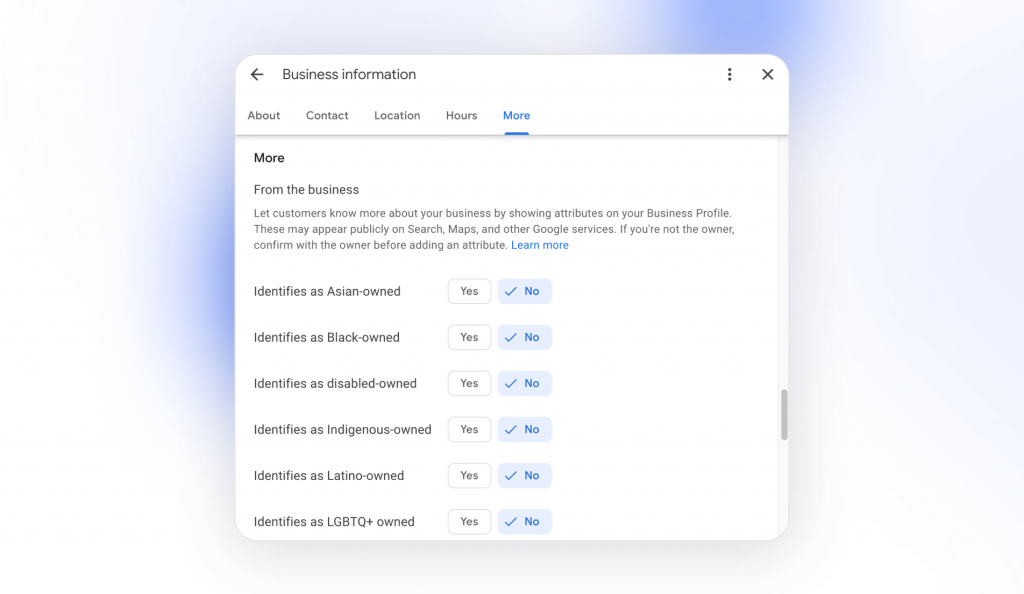
What Photos and Videos Does Google Reward?
High-resolution, authentic visuals drive clicks! EXIF geo-tagging no longer influences rank, but posting high quality images alongside snippets of customer feedback still helps. Aim for:
- Exterior + interior shots so visitors recognize the entrance (great for finding local businesses searches)
- Team photos that humanize the brand and boost business information trust signals
- 30-second vertical clips showing the service in action (Google prioritizes mobile-friendly video)
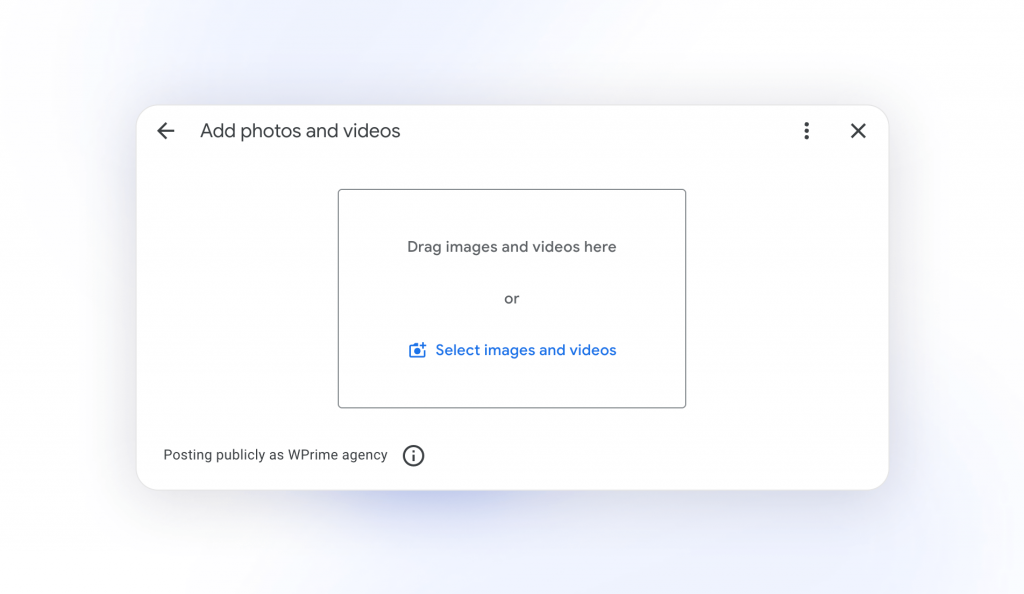
How Do the Products & Services Tabs Boost Conversions?
Populate products with high-margin offers—each needs a photo, short description, and “Call Now” CTA. List every core task in plain language under Services (e.g., “Drain Cleaning”).
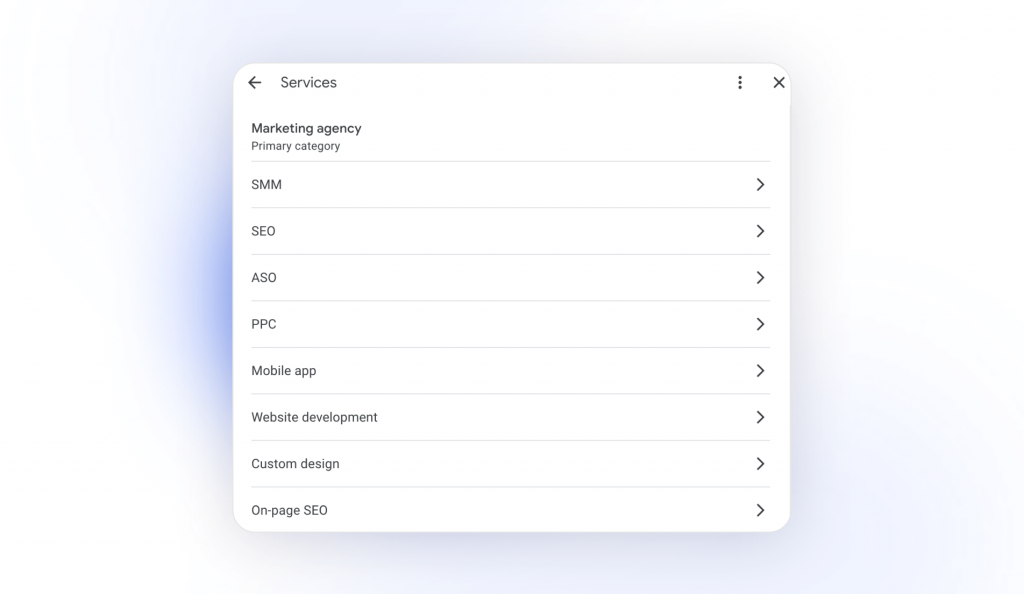
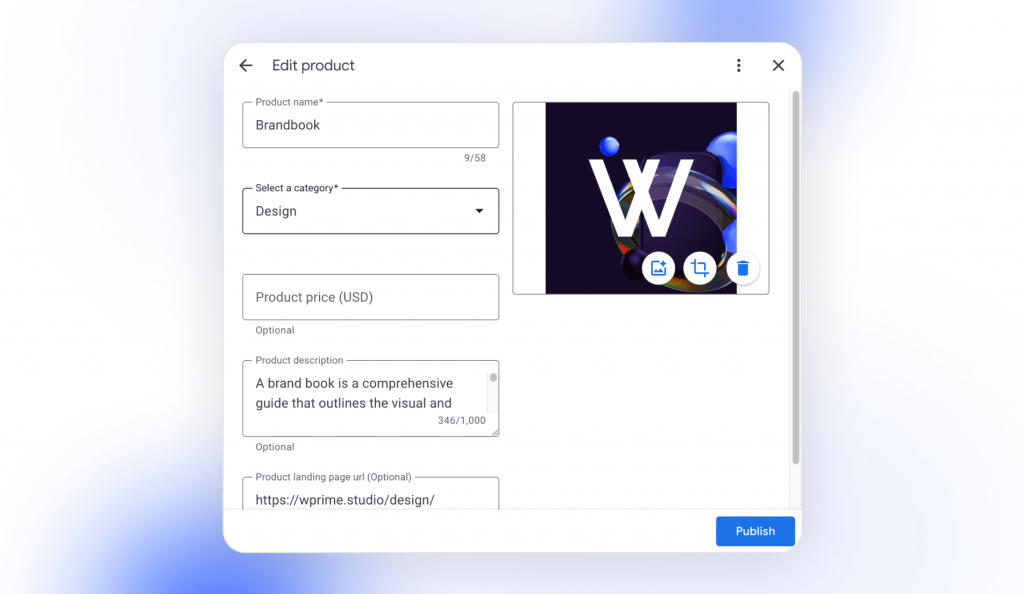
How Do You Prevent and Quickly Reverse GBP Suspensions?
Most disappearances trace back to NAP mismatches, category spam, or keyword-stuffed names. Keep a one-page SOP: check NAP consistency → audit categories → submit the reinstatement form with photo proof (signage, license, utility bill) and links from local business directories like Yellow Pages or other websites with matching local citations. Clear evidence usually restores visibility within 2–5 business days.
How Should You Handle Special and Holiday Hours at Scale?
Nothing tanks trust faster than a “Closed” label when you’re open. Use Google’s Holiday Hours feature (effectively a free tool built to optimize your Google Business listing) and bulk-upload via spreadsheet or API if you manage many locations. Listings then display “Hours verified by business,” an instant credibility boost that attracts more customers during local events and beyond.
Reviews & Reputation for Local SEO: Turn Social Proof into Rankings and Clicks
When two businesses sit equidistant from a searcher, reviews decide the click. Google treats them as proof of real-world quality, while shoppers read them as insurance against disappointment. Get the volume, freshness, and tone of your reviews right and you climb the Local Pack. But let them stagnate and you slide.
How Many Google Reviews Do You Really Need to Rank?
Google never publishes a magic number, yet field data points to three practical benchmarks:
| Milestone | What It Signals | Typical Impact |
| 10–15 reviews | Legitimate, operating business | Eligibility for Local Pack on long-tail queries |
| 50+ reviews | Consistent service history | Visibility on core “service + city” keywords |
| 100+ reviews with ≥4.5★ | Market leader status | Higher click-through rate; competitive moat |
More matters, but velocity (steady trickle) and keyword-rich comments often outweigh sheer count.
How Can You Generate Reviews at Scale Without Spamming?
Getting steady, authentic reviews is a process, not a one-off push action to improve local SEO. The goal is to embed a “review loop” into your normal customer journey so every happy client receives a nudge while the experience is still fresh.
Before you start, prepare three items for your local SEO strategy:
- A direct Google review link (create it in GBP → “Get more reviews”).
- A short thank-you script your team can personalize.
- An automation tool—most CRMs, Podium, or Birdeye can send templated emails/SMS.
Once those pieces are ready, follow the loop below.
| Stage | What Happens | Practical Tips |
| 1. Trigger | Job is marked “complete” in your CRM/POS. | Tie the trigger to a discrete event (invoice paid, table closed, appointment checked out). |
| 2. Channel | System sends an SMS or email within 2 hours. | SMS gets ~3× higher open rates than email; use both if possible. |
| 3. Message | Short, polite note: “Hi {First Name}, thanks for choosing {Business} today. Could you spare 30 seconds to share your experience?” | Keep it under 160 characters; emojis boost response on mobile. |
| 4. Link | Button or shortened URL opens the Google review form directly. | A direct link cuts friction by ~30 %. Generate it via your Place ID or GBP “Get more reviews” button. |
| 5. Fallback | Hand a wallet-size QR card to customers who prefer offline receipts. | Print the card with a friendly line: “Point your camera here to leave a quick review.” |
| 6. Follow-up | If no review after 3 days, send one gentle reminder—then stop. | Avoid pestering; a single follow-up captures most stragglers without sounding pushy. |
| 7. Personal Touch | Staff can add a personal first sentence (“Hi Maria, thanks for trusting us with your roof…”) | Internal tests show personalizing lifts conversions by ≈18 %. |
Important: send every customer the same request—no filtering “happy” vs “unhappy” segments—and never offer discounts or gifts for reviews.
Build this loop once, and review generation becomes a background task that keeps velocity, and recency signals strong without overwhelming your team—or your customers.
How Should You Respond to Negative Reviews?
Bad reviews scare owners, but silence scares prospects more. A simple template can be something like this:
“Hi [Name], we’re sorry your experience fell short. I’ve emailed you personally to fix this—please reach me at [direct contact]. Thank you for the feedback; it helps us improve.”
Acknowledging, owning, and moving the conversation offline shows future readers you are accountable—often prompting the critic to update their rating.
Is Review Gating or Incentivizing Allowed in 2025?
No. Google’s policy and the U.S. FTC both prohibit offering discounts or filtering unhappy customers out of the survey flow. Violate the rule and your risk:
- Immediate review removal or profile suspension
- Fines up to $53,088 per incident under FTC guidelines
Instead, ask every customer transparently and let the volume of happy experiences balance the occasional bad one.
NAP & Citations for Local SEO: Proving Your Real-World Location to Google
Customers can forgive a slow page, but they rarely forgive driving to the wrong address. For local SEO success, Google is the same: if your address and phone number (NAP) varies across local listings on major business local directories and other websites, the search engines assume you’re unreliable and swap you out in the local search results for a competitor with cleaner local citations.
Tightening your NAP doesn’t just stop mis-dials—it raises every “prominence” score Google tracks, boosts Map Pack stability, and protects you from the soft suspensions that often follow inconsistent signals—crucial local SEO optimization advice for any local business owner.
How Much Does NAP Consistency Matter in 2025?
A latest 2024 dataset shows businesses with 100 % matching NAP across the top 25 local business directories average 18 Map-Finder positions higher than those with three or more variants—proof that clean data can improve local rankings and drive tangible local SEO benefits.
Another insight: online listings updated in the last 60 days receive 12 % more profile actions because Google surfaces “recently edited” data with extra confidence tags. In short, match everything—then keep it fresh to increase local SEO traction and stay visible in both Google Maps and the broader organic search results.
Where Should You List Your Business First to Boost Local SEO?
Google crawls thousands of sites yet still leans on a “citation core.” Secure these before worrying about long-tail local directories:
| Tier | Platform | Why it matters |
| Primary | Google Business Profile, Apple Business Connect, Bing Places | Direct feed into mobile OS map apps and desktop search. |
| Trust Hubs | Yelp, Facebook Pages, Better Business Bureau | High DA and consumer-trust signals; often pulled into Knowledge Panels. |
| Data Brokers | Foursquare, TomTom, YP.com | Supply GPS systems, review widgets, and third-party local apps. |
Tip: if you serve a regulated niche—health, legal, home services—add one industry directory early (e.g., Avvo for lawyers, Healthgrades for clinics). These sites seed knowledge-graph links Google can’t get elsewhere.
Should You Pay a Data Aggregator Or Go Manual?
Aggregators such as Data Axle, Neustar Localeze, and Foursquare’s data-cloud distribute your NAP to hundreds of smaller sites, including ones you’ve never heard of, but Google still scrapes. They cost roughly $70–$100 per location, per year.
When manual wins:
- Single-location or static address (no moves in five years)
- Tight marketing budget and time to claim five–six core listings
When an aggregator pays for itself:
- 5+ locations or frequent address/phone changes
- Need to suppress rogue listings after a rebrand
- Want automated “lock” so competitors can’t suggest edits
Cancelling a subscription can sometimes roll your listings back to the old data. If you plan to stop, pull a full citation export first.
How Do You Clean Up Old or Duplicate Citations?
Messy legacy data spreads like ivy. A pragmatic three-step loop keeps it in check:
| Step | Action | Tool Tip |
| 1. Scan | Google “Business Name” + old phone/address; export mismatches into a sheet. | Use operators like inurl:»/biz» to surface buried Yelp clones. |
| 2. Fix | Claim the listing, update NAP, then mark obvious duplicates for deletion or merge. | Whitespark’s free duplicate finder speeds this step by clustering URLs. |
| 3. Monitor | Set a monthly reminder to re-run the query; rogue data often re-enters via user edits or scrapers. | Google Alerts on your old phone number catch new leaks early. |
Here’s an e-mail template for a merge request that you can use:
Subject: Duplicate Business Listing—Merge Request
Body: “Hi [Directory Name] support, our business appears twice: [URLs]. The correct listing is the first; please merge or delete the duplicate to avoid confusing customers. Proof attached.”
If you write clear, polite, and with links, support teams respond faster.
Local Keyword Research & Mapping: Finding the Queries That Drive Local Buyers
Before you publish a single “service-in-city” page, you need to know what real people type into Google and the wider local search engine landscape. Solid local keyword research turns guesswork into a roadmap, making sure every URL targets a phrase with high purchase intent, zeroes in on the most relevant keywords, strengthens your overall local search engine optimization signals, and avoids keyword cannibalization across the site.
Think of this step as laying track—without it, none of the trains in your local SEO strategy will run on time or deliver the full benefits of local SEO.
How Do You Discover Seed Keywords That Locals Actually Use?
Your goal is to capture the exact language prospects enter into Google local search when they need a solution fast. Instead of guessing, mine data from three free sources that mirror real-world demand:
- Google Autocomplete – Begin typing a core service and let Google finish your thought (e.g., “hvac repair ch…” ➝ Chicago). Those dropdown suggestions represent live searches—you’re seeing demand in real time.
- Google Search Console (GSC) – Filter existing impressions by city or state and export the query list. Phrases ranking in positions 20-40 have shown potential; a small optimization often lifts them to page one.
- Competitor Title Tags – View source on top Local Pack results. Consistent phrasing across multiple competitors (“emergency plumber Dallas”) signals a proven keyword worth targeting in your own local landing page.
Add each term to a sheet. This becomes the foundation of your local SEO optimization plan.
Why Do Local Modifiers and “Near Me” Variants Matter?
After identifying core terms, layer on local SEO modifiers—words that reveal urgency or proximity. These tweaks convert searchers into callers because they imply immediate need:
- “best roofing company near me” – high intent, no brand loyalty
- “thai food wicker park” – neighborhood modifier captures hyper-local diners
- “24/7 locksmith 90210” – ZIP code searches signal urgency plus precise location
Although volumes are smaller, conversion rates skyrocket, making these phrases critical for local business SEO.
How Do You Classify Intent and Map Keywords to the Funnel?
Not every query is created equal. Classifying intent lets you serve the right content to the right searcher and stops pages from competing with one another:
| Intent Type | Example Query | Funnel Stage |
| Commercial | “affordable dentist Austin” | Ready to compare providers |
| Transactional | “emergency dentist Austin open now” | Needs service immediately |
| Informational | “how much is a dental crown in Austin” | Researching cost/options |
Commercial and transactional queries belong on city or service pages, they drive bookings. Informational questions fit blog posts or FAQ sections, answering early-stage concerns and feeding internal links back to your money pages. This structure keeps your local SEO strategy laser-focused and prevents cannibalization.
How Do You Map Keywords to Pages Without Cannibalization?
Once intent is clear, create a simple keyword-to-URL matrix. Think of it as an accountability chart so every keyword has “one home”:
- Assign one primary phrase (a valuable local keyword) to each page (title tag + H1).
- Place close variants in H2/H3 sub-heads or FAQ snippets—never cram them into a single sentence.
- If two pages end up with the same “service + city” focus, merge or canonicalize. Google punishes duplicate local content, so keep each page distinct.
Documenting this matrix upfront makes future content-planning painless and scales smoothly as your SEO for local businesses expands to new cities.
How To Optimize On-Page & Local Content for Local SEO
A polished Google Business Profile gets you on the map, but your website persuades Google to keep you there. Pages must prove three things:
- Where you operate,
- What you offer, and
- Why you deserve the click.
So, the most important thing here is to show Google clear, consistent evidence of your local relevance, and it will prioritize your pages. If you leave gaps in that evidence and the algorithm assumes you’re just another generic site – it will start shuffling you behind neighbors who spell out their location signals.
How Should You Structure Location and Service Pages?
Visitors land with two questions: “Do you serve my area?” and “Can you solve my exact problem?” Splitting content into city hubs and service pages answers both without keyword cannibalization.
Remember to use all found keywords everywhere in the content.
City hub pages target “service + city” queries and reassure users you’re local. Service pages dive deep into benefits, pricing, and FAQs for one offering.
| City Hub Must-Haves | Service Page Must-Haves |
| Hero headline: “Emergency Plumbing in Austin” | Benefit-driven H1: “Hydro-Jet Drain Cleaning” |
| Neighborhood list + map | Step-by-step process + timeline |
| Local EEAT block (team photo, license) | Warranty / guarantee details |
| Review widget filtered to that city | Before-and-after gallery |
| Sticky “Call Now” button | Contextual upsells (“Pipe inspection”) |
Pro tip: Cross-link the two levels: city → service and service → city to keep crawl depth shallow and pass topical authority in both directions.
What Does a High-Converting City Page Look Like?
A good city page feels written for locals. Open with a concise 40-word paragraph that states coverage area and average response time. Then layer on credibility:
- EEAT snapshot – headshots, license numbers, years in operation.
- Mini price range – “Most jobs $79–$189, parts extra.”
- Landmark anchor – “Five minutes from Zilker Park.”
- Services descriptions – short but explaining exactly what you can do for your customers.
- Local testimonials – quote customers by first name + suburb.
- Scrolling CTA – mobile-first click-to-call stays fixed at bottom.
Pages that combine hyper-local context with tangible proof consistently see 15 – 25 % higher call-through rates.
Of course, this is a general framework. Each element should be adapted to your specific niche and customer expectations for maximum impact.
How Do You Build Internal Links That Pass Local Authority?
Googlebot judges importance by the number and context of links pointing to a page. Use a hub-and-spoke pattern:
- From service pages include an anchor text like “Plumbing in Plano” pointing up to the corresponding city hub.
- From each city hub link down: “See all drain-cleaning services”.
Add a small “Related Locations” widget in the footer to connect nearby suburbs. This distributes PageRank without overwhelming navigation.
Which Schema Mark-Up Matters Most for Local SEO?
Google’s crawler parses HTML of your page. Schema tells it how to interpret that HTML. Important things to implement:
- LocalBusiness (or subtype Dentist, AutoRepair) – name, geo, hours.
- Service – price-range, area-served, ServiceType.
- FAQPage – wrap real Q&A; surfaces accordion rich snippets.
Validate with Google’s Rich Results Test and keep JSON-LD snippets under 10 kB to avoid bloating the DOM.
How Fast Should Your Pages Load and Why Does Google Care?
Sluggish pages signal poor user experience, and Google’s Core Web Vitals algorithm now bakes that frustration directly into local pack positioning and the wider search engine results.
Hitting the benchmarks below not only keeps you out of the penalty zone but also improve local rankings. For many sites, simply compressing the above-the-fold hero image from JPG to WebP can slash up to 400 ms from load time—often the final push into “good” territory—while still delivering high quality images.
Even a slow-loading Google Maps embed can tank LCP.
| Metric | Pass Threshold | Quick, High-Impact Fix |
| Largest Contentful Paint (LCP) | < 2.5 s | Lazy-load the hero image and serve it in WebP format |
| Cumulative Layout Shift (CLS) | < 0.10 | Reserve fixed space for ads, embeds, and iframes |
| Interaction to Next Paint (INP) | < 200 ms | Minify JavaScript and defer non-critical scripts |
What Makes a Local Landing Page Convert Visitors into Calls?
Getting ranked is step one. Step two is turning that click into a phone ring. A high-performing local landing page removes every ounce of doubt a visitor might have about reaching out like “Is this business really nearby? Can I trust them? How fast will they respond?” Build answers to those silent questions straight into your layout and the call volume follows.
- Phone-first header – tap-to-call in the top-right. Over half of all local searches (about 57 %) are performed on a mobile phone or tablet.
- Directional micro-copy – “Near Barton Springs Pool” anchors physical context.
- Trust seals – BBB rating, Google review badge, and local chamber logo.
- Micro-FAQ – Three collapsible Qs that pre-empt price or time objections.
- Sticky bottom bar – “Text Us Now” catches users not ready to call.
A/B tests on service-industry sites show these tweaks raise booked-job rates by 15 – 22 %.
Mobile Optimization for Local SEO: Turning Micro-Moments into Customers
More than half of local searchers now use a phone, often just minutes before buying in their local area, so a mobile-first mindset is the foundation of every effective local SEO strategy.
If your pages lag, shift, or hide the address and phone number, those ready-to-buy visitors bounce to a competitor whose site loads faster and shows a tap-to-call button.
The tactics below make sure your local search engine optimization isn’t crippled by a desktop-first approach and that every micro-moment ends with your business getting the call—showing up in both the Map Pack and organic search results.
How Do You Build a Mobile-First Page Design and UX?
Mobile searches are impatient. Design your website from the small screen out:
- Responsive grid—single-column layout, 16-pt body text, thumb-reachable buttons.
- Above-the-fold essentials—logo, value prop, star rating, and CTA visible without scrolling.
- Local cues—city name in the hero headline (“Emergency Plumber • Austin, TX”) and a mini map so users instantly know you serve their neighborhood.
Local SEO tip: Google’s Mobile-Friendly Test flags tap targets that are too close together—spreading them by just 8 px often flips a “Fail” to a “Pass,” boosting mobile local SEO scores.
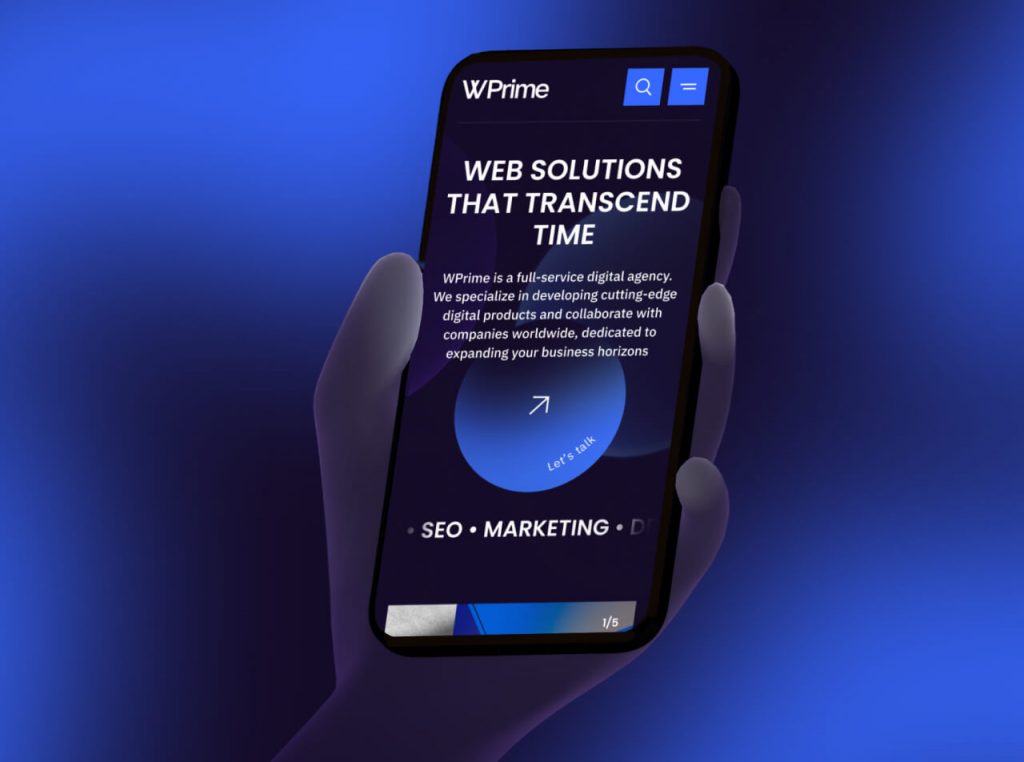
Where Should You Place Tap-to-Call and Tap-for-Directions CTAs?
A mobile visitor is holding the very device you want them to use—make conversion friction-free.
- Call Button—use tel: links and position the button top-right on every page.
- Directions Button—https://www.google.com/maps/dir/?api=1&destination= links open Google Maps with one tap.
- Sticky footer bar—shows “Call Now” on scroll; A/B tests across service sites increase call volume by 15 – 22 %.
Track these actions as primary goals in GA4 to prove ROI on your local SEO work.
How Fast Is “Fast Enough” for Mobile Core Web Vitals?
Google rewards pages that feel instant on 4G. Aim for these mobile Core Web Vitals:
| Metric | Target | Quick Fix for Local Sites |
| Largest Contentful Paint (LCP) | < 2.5 s | Compress hero image to WebP; lazy-load below-the-fold images |
| Cumulative Layout Shift (CLS) | < 0.10 | Reserve space for GMB embed & review widgets |
| Interaction to Next Paint (INP) | < 200 ms | Minify JS, defer chat widgets until user scroll |
Meeting these speeds boosts rank and pushes more local SEO traffic into real calls.
How Do You Win Prime Mobile SERP Real Estate?
On a phone, you either own the first swipe or you’re invisible.
- Map Pack dominance—complete Google Business Profile, earn fresh reviews, and keep NAP consistent; these signals lock you into the top three local slots.
- Rich snippets—FAQ schema can double vertical space, pushing competitors below the fold.
- Review stars—structured data under 150 ms fetch time keeps stars visible beside your result, lifting CTR by up to 35 % in local search results.
Remember: mobile screens show fewer results, so every pixel of extra SERP real estate translates into more calls.
Service-Area Business (SAB) Local SEO Strategy: Winning Beyond Your Address
If your company travels to customers—plumbers, roofers, mobile pet groomers—you’re what Google calls a service-area business (SAB). Unlike a storefront, you can’t rely on walk-in proximity alone. The challenge is signaling that you truly serve a neighborhood, city, or entire metro so you still win clicks in local search results. The tactics below show how to beat the “distance handicap” without bending Google’s guidelines for local search engine optimization.
How Do SABs Rank When Proximity Works Against Them?
Google’s local algorithm, especially after the Vicinity update, puts heavy weight on distance. An SAB can offset that bias by strengthening the other two pillars: Relevance and Prominence.
- Max out category relevance. Pick a primary Google Business Profile category that matches your most profitable service (“Water Damage Restoration Service” > generic “Contractor”).
- Expand topical authority on your site. Publish service-specific landing pages with FAQs, pricing ranges, and photos of real field crews.
- Earn locally themed backlinks. Sponsor neighborhood events or hyper-local blogs; a single authoritative .org link can nudge you past closer competitors.
Local SEO tip: Split-test (A/B) title tags with and without neighborhood names. In many metros, adding the neighborhood raises click-through rate even if you rank one position lower.
How Many Service Areas Should You List—and Which Ones?
Google allows up to 20 service areas per listing, but more isn’t always better. Choose areas you can reach in ≤45 minutes under normal traffic; anything farther risks bad reviews for late arrivals.
| Scenario | Recommended # of Areas | Reasoning |
| Solo owner-operator | 3–5 core ZIPs | Keeps drive times consistent |
| Small crew (3–5 trucks) | 8–12 ZIPs or neighborhoods | Covers city + close suburbs |
| Regional brand | 1 SAB listing per hub city | Use multiple GBP listings, not 20+ areas in one profile |
Stick to concentric rings around your office; listing scattered ZIP codes can dilute local search optimization signals and confuse Google’s service-area polygon.
How Do You Scale Local SEO for Multi-Location Enterprises?
Expanding from one storefront to 50—or 5,000—multiplies every ranking factor and risk. A single NAP typo can echo across hundreds of listings, and internal teams often fight over which page or Google Business Profile (GBP) should rank for a shared keyword. The frameworks below show how to keep enterprise-level multi-location local SEO predictable, compliant, and profitable.
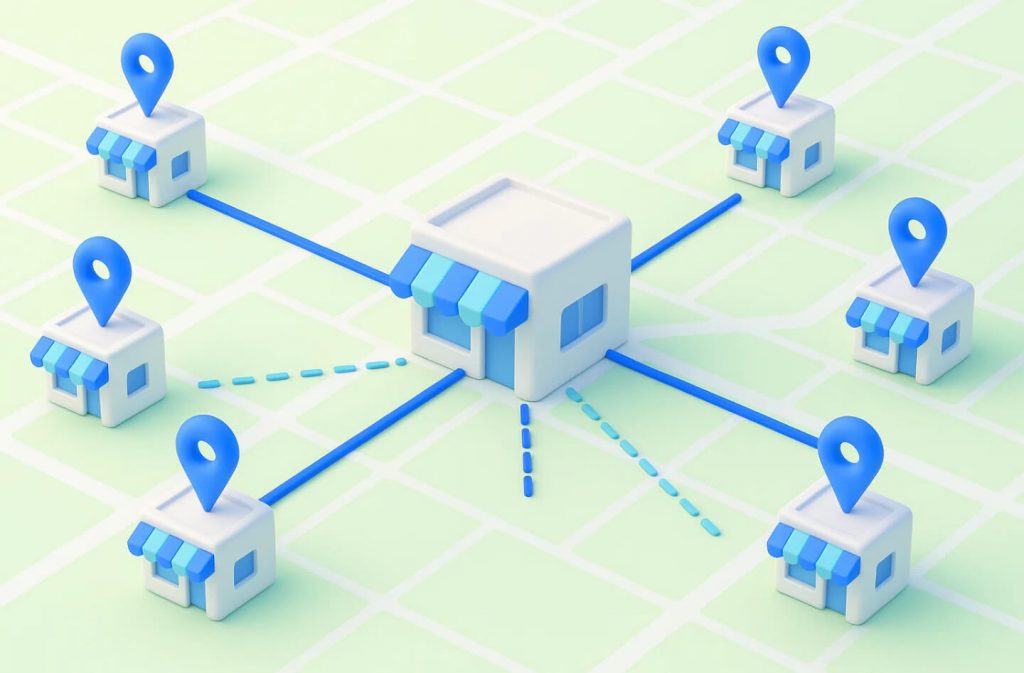
What Does an SEO-Friendly Store-Locator Architecture Look Like?
Search engines, and customers, must reach any branch in two clicks or fewer. Build a three-layer hierarchy:
- /locations/ – indexable master map with search and filter.
- /state/ pages – e.g., /texas/ (optional for large brands).
- /city/brand-name/ – fully optimized landing page per branch.
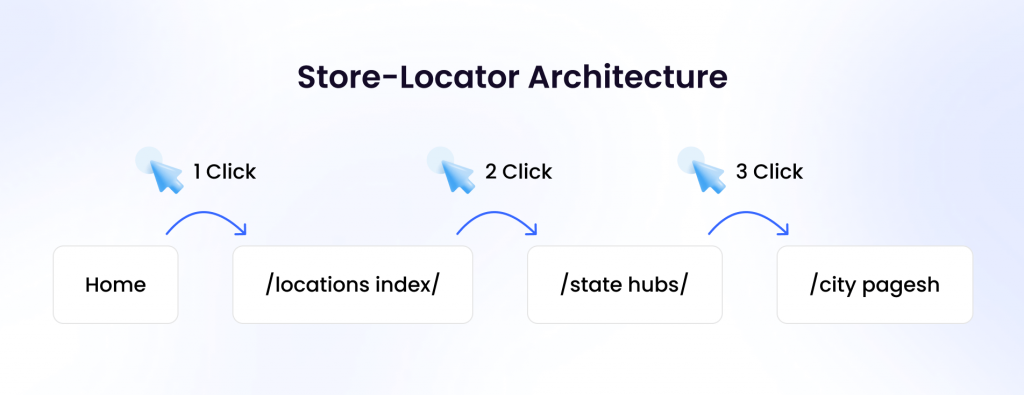
Each city page needs:
- H1 “{Service} in {City}” + embedded map pin.
- Unique NAP and PostalAddress schema.
- Local reviews widget filtered to that branch.
- Internal links back to the master locator and nearest sibling cities.
Keyword tip: Pair the city name with a high-intent modifier—“dentist near me Austin”—to capture local search optimization queries without cannibalizing service pages.
How Can You Manage Hundreds of Google Business Profiles Without Chaos?
Manual updates break at scale. Switch to a bulk-management stack:
| Need | Best-Practice Tool / Process | Enterprise Benefit |
| Mass NAP edits | GBP “Bulk Location Management” spreadsheet upload or API | Changes propagate in hours, not weeks |
| Scheduled holiday hours | CSV upload via GBP dashboard | Eliminates “Closed” label on peak days |
| Photo & post automation | Third-party platforms (e.g., Yext, Uberall) with API scheduling | Maintains freshness signals across all listings |
| Review response at scale | Unified inbox with canned replies + branch-specific tokens | Cuts response time while keeping local voice |
Automating these tasks safeguards enterprise local SEO against human error and ensures every branch meets Google’s freshness and accuracy benchmarks.
How Do You Build Off-Page Authority for Local SEO?
Google’s local search algorithm still counts backlinks as votes of confidence, especially links from websites rooted in your service area. Combine smart outreach with precise internal linking and you’ll lift both local search engine optimization rankings and credibility with human visitors.
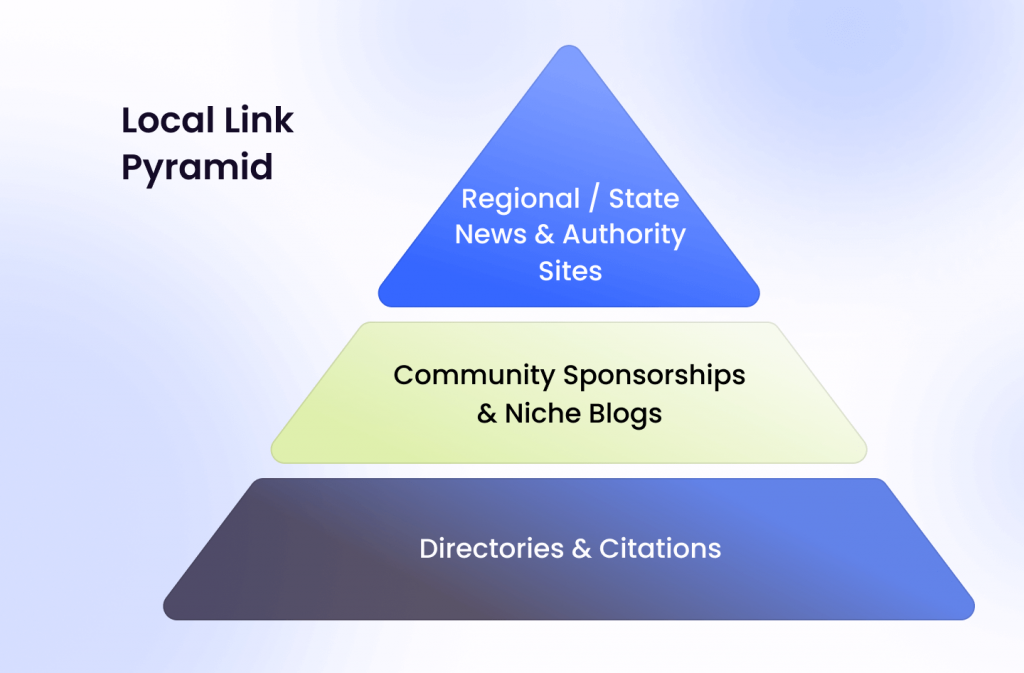
What Does a Future-Proof Local Link-Building Playbook Look Like in 2025?
Gone are the days of mass directory submissions; today’s high-value links come from genuine community ties:
- Neighborhood Media & Blogs. Pitch seasonal how-to articles (“Prevent frozen pipes in Toledo winters”) and include a do-follow link to your resource hub.
- Local Sponsorships. Sponsor Little League teams or charity 5Ks. Request a sponsor spotlight page that links to your home or city page.
- Industry Associations & Chambers. Most offer member profiles—opt for the paid tier only if it includes a live website link.
- Geo-Targeted Digital PR. Use free HARO or paid Qwoted alerts filtered by state to earn quotes in regional news outlets.
Local SEO tip: One link from a respected regional newspaper can outweigh 20 generic directory links in boosting local search optimization authority.
How Should You Link Back to City or Service Pages Without Over-Optimizing?
Passing external authority to the right place is half the battle:
- Anchor text rule: combine a natural phrase with the city or service one time (e.g., “see our roof repair team in Denver”).
- Canonical structure: always point media links to the canonical city or service page—not to temporary campaign URLs.
- Cross-link once on the page: inside your own site, place a single contextual link from the company blog to the city/service page; avoid site-wide footer spam.
Used together, external local links + strategic internal anchors boost topical relevance and keep your local business SEO footprint squeaky-clean.
How Do You Earn Visibility in Google’s AI-Powered Search (SGE)?
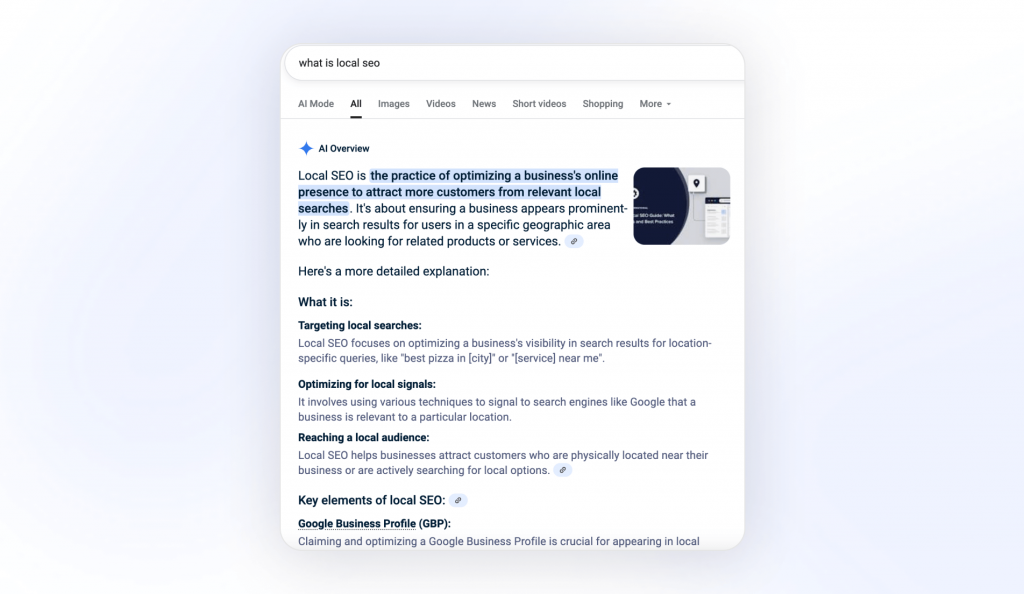
Google’s Search Generative Experience (SGE) pulls answers from brands it already understands as trusted entities. If your company’s data is thin or scattered, the AI can’t “see” you—even if your local search engine optimization is on point.
The good news: local businesses have an edge because they’re tied to real addresses, reviews, and news coverage. The tactics below show how to turn that real-world footprint into citations the AI can quote.
How Does Entity-Led Digital PR Create SGE Citations?
SGE favors sources that appear repeatedly across authoritative sites and structured data. Think of each mention as a brick in your brand’s Knowledge Graph wall.
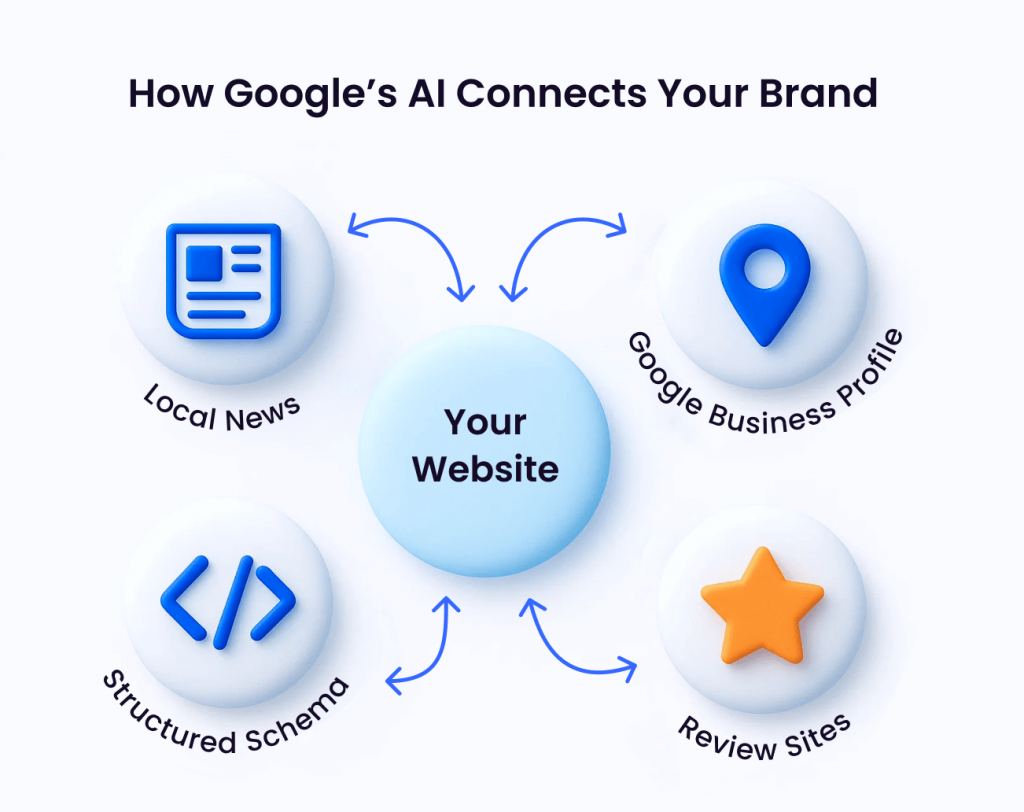
- Local News & Niche Outlets. Pitch community-focused stories (“Veteran-Owned HVAC Donates AC Units to Seniors”). Include your full Name, Address, Phone and link—this reinforces the entity.
- Expert Commentary. Register on HARO/Qwoted with geo-tags. Answer service-area questions (“What roof material suits Denver’s climate?”). Each published quote cements topical authority.
- Structured Citations. Add sameAs links in LocalBusiness schema pointing to these PR wins. This helps SGE connect the dots between your Google Business Profile and off-site mentions.
Local SEO strategy tip: One high-authority regional news link with proper Organization schema can surface your brand in AI panels—even outranking larger national chains for local queries.
How Do You Get Cited in AI Overviews Without Spam?
AI Overviews scan for concise, fact-rich passages that directly answer the user’s local question. Optimize your content so the model can lift a ready-made nugget:
- Write Q&A blocks with city modifiers (H3: “How much does dryer-vent cleaning cost in Tacoma?” ➔ 40-word answer).
- Place the business entity near the answer (“According to ABC Vent Cleaning in Tacoma …”). Models prefer self-attributed facts.
- Embed FAQPage or HowTo schema—SGE often extracts from JSON-LD because it’s cleaner than raw HTML.
- Update freshness signals—SGE values current data; refresh cost ranges, hours, and review counts at least quarterly.
How Do You Measure Local SEO Success?
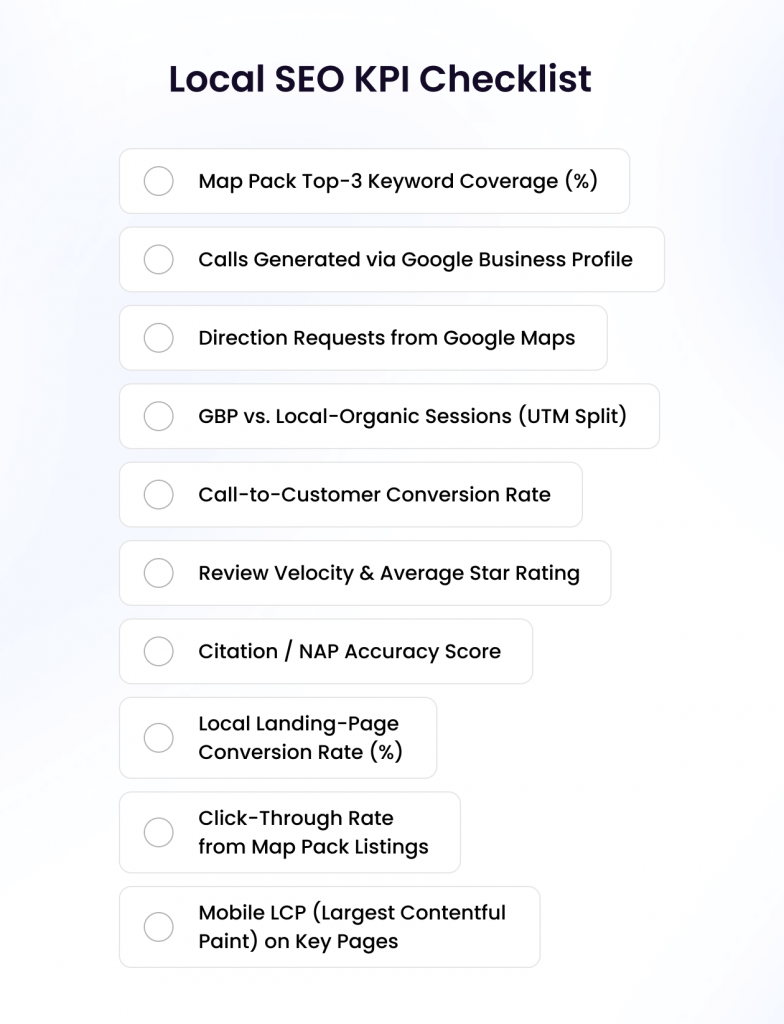
Ranking screenshots look good in a pitch deck, but real-world local business SEO wins show up in calls, foot traffic, and booked jobs. Effective tracking separates look-busy vanity metrics from revenue-driving KPIs so you can double-down on what works (and kill what doesn’t).
The three tools below—GA4 + UTMs, call-tracking/DNI, and Google Business Profile Insights—give a 360-degree view of every click, tap, and ring your local search optimization generates.
How Do You Use UTMs and GA4 to Split “Local Organic” From “GBP” Traffic?
A website visit is not just a website visit; it matters whether it came from the Map Pack or a ten-blue-links result. Tagging URLs with UTM parameters lets Google Analytics 4 report them as separate channels.
Add UTMs to GBP links
URL example:
https://example.com/?utm_source=google&utm_medium=organic&utm_campaign=gbp
utm_medium=organic keeps sessions grouped under Organic Search while the utm_campaign label isolates Google Business Profile traffic.
Build GA4 custom channel groups
Define one for “GBP Organic” using the campaign name, and another for “Local Organic (SERP)” using default organic traffic minus GBP.
Key metric for local SEO success: compare Goal Conversion Rate of GBP visitors vs. local-organic SERP visitors; the spread shows where to focus CRO efforts.
Why Is Call Tracking with Dynamic Number Insertion (DNI) a Must for Local SEO?
Local buyers still prefer the phone, but default analytics can’t tie calls back to keywords. DNI swaps phone numbers on the fly based on the visitor’s source:
| Visitor Source | Number Shown | Logged Attribute |
|---|---|---|
| Map Pack click | (555)-1000 | “GBP – Local Pack” |
| Organic city page | (555)-2000 | “Local Organic” |
| Google Ads | (555)-3000 | “PPC – Brand” |
Route these numbers to one line; the caller never notices. In your call-tracking dashboard, filter by source to see which local search engine optimization tactics produce actual conversations—and, by extension, revenue.
Tip: Sync call events to GA4 via Measurement Protocol so phone conversions join form fills in one report.
Which Google Business Profile Insights Actually Matter?
GBP offers dozens of data points; three correlate most with business growth:
| Metric | Why It Matters | Target / Action |
|---|---|---|
| Calls | Immediate, high-intent leads | Trend up ≥10 % QoQ |
| Direction Requests | Foot-traffic predictor | Compare against store visits |
| Discovery Searches | Visibility for non-brand queries | If flat, update categories & posts |
Export Insights monthly, pipe into Looker Studio, and set anomaly alerts—e.g., a 20 % drop in calls week-over-week triggers a citation or ranking audit.
Where Should You Start with Local SEO?
Even the best local search engine optimization plan drifts over time. A concise audit keeps your data clean, while the right partner frees you to run the business instead of chasing citations. Use the checklist below to benchmark your current state, then weigh agencies against clear, ROI-focused criteria.
What Should Your Local SEO Audit Checklist Cover?
Before adding new tactics, confirm the fundamentals are sound. Run this local SEO checklist every quarter (or after major site changes):
- Google Business Profile – verified, correct categories, NAP match, fresh photos.
- On-Site Basics – unique title tags with city/service, LocalBusiness schema, <2.5-second mobile LCP.
- Citations & NAP – top 25 local directories consistent; no duplicates or old phone numbers.
- Reviews & Ratings – ≥50 Google reviews, 4.5-star average, <7-day average response time.
- Local Content – city pages with landmark references, FAQ blocks, internal links from blog posts.
- Backlinks – at least five hyper-local links (news sites, chambers, .org sponsorships).
- Tracking & KPIs – UTM-tagged GBP links, call tracking with DNI, GA4 goals for calls and directions.
How Do You Choose a Local SEO Agency That Delivers Real Results?
A polished pitch deck is easy; sustained growth in local search results is hard. Use these five litmus tests before signing:
- Proven Local Wins – ask for before-and-after call volumes or Map Pack rankings—screenshots alone don’t cut it.
- Transparent Reporting – monthly dashboards that separate local organic, GBP, and paid traffic.
- Citation Control – in-house or vetted platform for bulk edits; no “set-and-forget” directory spam.
- Review Strategy – concrete plan for email/SMS requests and public response SOPs.
- Contract Flexibility – 30-day out clause; real experts don’t need year-long lock-ins to prove value.
If juggling all the pieces of local SEO sounds like one task too many, we can lend a hand. WPrime crew spends its days fine-tuning these levers for businesses of all sizes and quietly passing the wins back to your bottom line. You stay focused on customers; we’ll keep the leads flowing and the numbers transparent.
Final Takeaway
Local buyers are already searching for what you offer. Follow the steps in this guide (and our checklist), track what moves the needle, and adjust as you grow. And remember: whether you go DIY or bring in backup, consistent, customer-focused action beats one-time fixes every time.
Faq
Do I need a separate Google Business Profile for each department inside one location?
No. Google treats departments in the same building as a single entity—create one profile, then use “services” and attributes to highlight each department.
How often should I add new photos to my Google Business Profile?
Aim for at least one fresh photo every month; Google treats regular updates as an activity signal and may boost visibility.
Does posting on social media help local SEO?
Indirectly. Social posts themselves don’t boost rankings, but they can generate local backlinks, brand mentions, and fresh reviews—all of which support local search optimization.
What’s the fastest local SEO win for a brand-new business?
Verify your GBP, fill every field, and upload real photos. Many new listings hit the Map Pack for brand queries within a week.
Can running Google Ads improve my organic local rankings?
Ads don’t influence ranking algorithms, but the extra clicks and branded searches they create can strengthen behavioral signals that support long-term local SEO performance.
More articles
Please, rate this article
Overall rating 0 (0 vote(s))




Comments 0